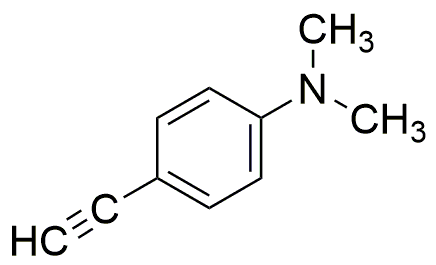4-Ethynyl-N,N-dimethylaniline is widely utilized in research focused on:
- Organic Synthesis: This compound serves as a versatile building block in the synthesis of various organic molecules, particularly in the development of dyes and pigments.
- Polymer Chemistry: It is used in the production of specialty polymers, enhancing properties such as thermal stability and chemical resistance, making it valuable in the plastics industry.
- Pharmaceutical Development: The compound plays a role in the synthesis of pharmaceutical intermediates, contributing to the creation of new medications and therapeutic agents.
- Material Science: It is applied in the formulation of advanced materials, including conductive polymers, which are essential in electronics and energy storage applications.
- Research and Development: This chemical is frequently employed in academic and industrial research settings to explore new chemical reactions and develop innovative applications.
General Information
Properties
Safety and Regulations
Applications
4-Ethynyl-N,N-dimethylaniline is widely utilized in research focused on:
- Organic Synthesis: This compound serves as a versatile building block in the synthesis of various organic molecules, particularly in the development of dyes and pigments.
- Polymer Chemistry: It is used in the production of specialty polymers, enhancing properties such as thermal stability and chemical resistance, making it valuable in the plastics industry.
- Pharmaceutical Development: The compound plays a role in the synthesis of pharmaceutical intermediates, contributing to the creation of new medications and therapeutic agents.
- Material Science: It is applied in the formulation of advanced materials, including conductive polymers, which are essential in electronics and energy storage applications.
- Research and Development: This chemical is frequently employed in academic and industrial research settings to explore new chemical reactions and develop innovative applications.
Documents
Safety Data Sheets (SDS)
The SDS provides comprehensive safety information on handling, storage, and disposal of the product.
Product Specification (PS)
The PS provides a comprehensive breakdown of the product’s properties, including chemical composition, physical state, purity, and storage requirements. It also details acceptable quality ranges and the product's intended applications.
Certificates of Analysis (COA)
Search for Certificates of Analysis (COA) by entering the products Lot Number. Lot and Batch Numbers can be found on a product’s label following the words ‘Lot’ or ‘Batch’.
Número de catálogo
Número de lote/lote
Certificates Of Origin (COO)
This COO confirms the country where the product was manufactured, and also details the materials and components used in it and whether it is derived from natural, synthetic, or other specific sources. This certificate may be required for customs, trade, and regulatory compliance.
Número de catálogo
Número de lote/lote
Safety Data Sheets (SDS)
The SDS provides comprehensive safety information on handling, storage, and disposal of the product.
DownloadProduct Specification (PS)
The PS provides a comprehensive breakdown of the product’s properties, including chemical composition, physical state, purity, and storage requirements. It also details acceptable quality ranges and the product's intended applications.
DownloadCertificates of Analysis (COA)
Search for Certificates of Analysis (COA) by entering the products Lot Number. Lot and Batch Numbers can be found on a product’s label following the words ‘Lot’ or ‘Batch’.
Número de catálogo
Número de lote/lote
Certificates Of Origin (COO)
This COO confirms the country where the product was manufactured, and also details the materials and components used in it and whether it is derived from natural, synthetic, or other specific sources. This certificate may be required for customs, trade, and regulatory compliance.


